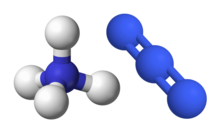
| |

| |

| |
| Names | |
|---|---|
| IUPAC name
Ammonium azide
| |
| Other names
Ammonium trinitride
| |
| Identifiers | |
3D model (JSmol)
|
|
| ChemSpider | |
| ECHA InfoCard | 100.032.093 |
| EC Number |
|
PubChem CID
|
|
CompTox Dashboard (EPA)
|
|
| |
| |
| Properties | |
| [NH4]N3 | |
| Molar mass | 60.060 g·mol−1 |
| Appearance | Colorless or white crystalline solid |
| Odor | Odorless |
| Density | 1.3459 g/cm3 |
| Melting point | 160 °C (320 °F; 433 K) |
| Boiling point | 400 °C (752 °F; 673 K) (decomposes) |
| Structure[1] | |
| Orthorhombic | |
| Pman | |
a = 8.930, b = 8.642, c = 3.800
| |
Formula units (Z)
|
4 |
| Hazards | |
| Occupational safety and health (OHS/OSH): | |
Main hazards
|
Very toxic, explosive |
| Related compounds | |
Other anions
|
|
Other cations
|
|
Related compounds
|
|
Except where otherwise noted, data are given for materials in their standard state (at 25 °C [77 °F], 100 kPa).
| |
Ammonium azide is the chemical compound with the formula [NH4]N3, being the salt of ammonia and hydrazoic acid. Like other inorganic azides, this colourless crystalline salt is a powerful explosive, although it has a remarkably low sensitivity. [NH4]N3 is physiologically active and inhalation of small amounts causes headaches and palpitations. It was first obtained by Theodor Curtius in 1890, along with other azides.
- ^ Frevel, Ludo K. (1 January 1936). "The Crystal Structure of Ammonium Azide, NH4N3". Zeitschrift für Kristallographie - Crystalline Materials. 94 (1–6): 197. doi:10.1524/zkri.1936.94.1.197. S2CID 100695095.